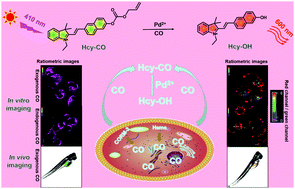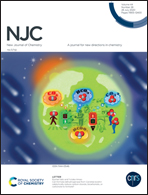The development of a hemicyanine-based ratiometric CO fluorescent probe with a long emission wavelength and its applications for imaging CO in vitro and in vivo†
Abstract
Carbon monoxide (CO) is a significant gasotransmitter and is related to various physiological and pathological behaviours. Because of the importance of CO in biological systems, many fluorescent probes for detecting CO in living organisms have previously been developed. However, some of them involve complex synthesis, are unstable and/or are unsuitable for biological CO tracking because of their short-wavelength emission. Herein, we report a novel ratiometric CO fluorescent probe (Hcy-CO) with long-wavelength emission, prepared using a simple synthesis method. The probe exhibits an ideal response speed (<10 s), long-wavelength emission (600 nm), and high sensitivity and selectivity towards CO. According to the results from tests using HeLa and RAW264.7 cells and zebrafish, Hcy-CO demonstrates in vitro and in vivo imaging abilities due to its above-mentioned distinct features. Overall, Hcy-CO could be a useful molecular tool for imaging CO with long-wavelength emission in vitro and in vivo.



 Please wait while we load your content...
Please wait while we load your content...